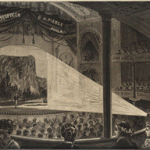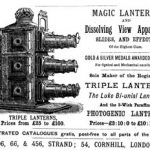Manufactured Puffs and Dissolving Views
Again this week I’ve been exploring details in P. T. Barnum’s letters that tell us about his “distance management” of the American Museum while he was on a three-year tour in Europe with Gen. Tom Thumb in the mid-1840s. No doubt he found some of the management quite tedious, such as having to settle differences between people, or in the case of the Giant and Giantess, seek legal settlement of a contract dispute. However, in true Barnum style he reveled in the opportunity while in Europe to hunt for attractions that captivated London and Paris audiences, with the idea of sending them to America. His museum manager was Fordyce Hitchcock, a man whom Barnum had known for years and in whom he placed great trust–which is saying something, because in those days honesty and trustworthiness were traits not readily found in the entertainment world. In fact, Barnum alerted Hitchcock that he had been receiving packets of malicious letters from men who were attempting to destroy the reputation of his faithful manager.
In other business correspondence, with a Mr. West from the New York Atlas newspaper for whom Barnum was acting as a foreign correspondent, Barnum roundly chastises the man for failing to personally go to the American Museum. On August 16th, 1845 he wrote from Bordeaux, “I have a word of complaint to make, and that is that you don’t find time once in a while to peep into the Museum & see what is going on. I know your taste lies with the theatres, but I have a good deal of pride in keeping up the old American Museum which gave me a start in the world, and although I do not need its profits, still do I mean to make it more and more worthy of public favor.” Barnum was feeling annoyed by West’s inattention because he had invested money in a new attraction and wanted West to praise it in an editorial or article, a more effective way to persuade the public than advertising. He goes on, “[if you would] just drop in an hour, one evening per week, whenever anything is new . . . you could scribble a few lines which would appear more like reality than all the manufactured puffs which could be written in a twelve-month.”

The new attraction? Dissolving views. Barnum explains, “Those dissolving views & “other fixins” which Professor Swift is bringing out actually cost me in London between 2000 & 3000 dollars, & I think will please the public highly, yet I see they are not even mentioned in the Atlas containing the advertisement of their first appearance.” Although Barnum could rightly claim many popular entertainment “firsts” at his museum, the reference to the advertisement of their first appearance should be understood to mean at his museum rather than the first time dissolving views had been shown. Ten months earlier, an ad for the Apollo Rooms appeared in the New York Herald (September 24, 1844), describing an exhibition of dissolving views: “Quite a novel exhibition takes place this evening at the above room, of a new instrument called the “Biscenoscope” which exhibits a very humorous series of dissolving views.” Articles in Baltimore, Maryland, and Alexandria, Virginia newspapers suggest that dissolving views were shown there in 1843 and 1844; a poem in praise of them was published several times.
The term dissolving views makes me think of Power Point slides formatted with the “dissolve” transition, but what were they in Barnum’s era? Essentially they were Magic Lantern presentations that utilized a bi-unial (two-lens) projector, and later a three-lens projector. Simply put, the double or triple lens with a single light source allowed one hand-painted slide view to be gradually transitioned to another view. Popular subjects were landscape scenes that changed from dawn to dusk, or fair weather to falling snowflakes, celestial views, and even gothic dramas with effects such as revealing the dreams of a sleeping person. The result was indeed “magical,” and the idea grew out of popular diorama and panorama visual entertainments of the 18th and 19th centuries that aspired to achieve lifelike special effects. (Think back to the thrill of your first time seeing a film in an IMax theater!)

Like many inventions from the past, identifying the exact who, what, and when of dissolving views’ origins isn’t simple. The earliest developments can be traced to the first decades of the 1800s in France and England, but it wasn’t until the 1840s that projected dissolving views were popularized. Significant credit is given to Henry Langdon Childe for his role, though others may have been responsible for more of the technical innovations. The special projector mentioned in the Apollo Rooms ad, the biscenascope, was introduced at the Royal Adelaide Gallery in London in December of 1840. Thus, when Barnum first arrived in England in the winter of 1844, this new form of dissolving views was still a novelty and he surely must have been anxious to acquire a set-up for his museum. Soon enough, with the runaway success of Gen. Tom Thumb in London and profits in his pockets, Barnum could afford the princely thousands asked by “Professor Swift.”
Still, Barnum had his limits. While in France he was busy trying to acquire grand panoramic scenes, sure that they would attract visitors to the American Museum. Painted canvas panoramas were designed to make viewers feel they were part of the scene (the virtual reality of that era), and they could be hundreds of feet long, requiring extensive structural set-ups in the round that “controlled” viewing in order to heighten the illusion. Although panoramas themselves were not new in America, Barnum had his eye on scenes he thought would be a draw: the palace of Versailles and scenes of Napoleon’s re-interment from the island of St. Helena to Paris, which took place in December 1840. On August 18th, 1845 Barnum wrote to Friend Huet,
I recd a letter from Messrs Molteni & Co the opticians, and . . . unfortunately their demands are too great for me. They ask 10,000 Francs for the Panoramas—viz 8000 for that of Napoleon and 2000 for Versailles. This is quite too much.
There is already a Panorama existing representing the funeral of Napoleon. It was made somewhere in Paris, and perhaps it is now there and may be bought for a low price.
I wish you to try to learn where it is and whether it is for sale. Mr. Robt. Houdin, a Physician (magician) is now performing in a salon in the Palais Royale—he knows me—I have bought 4000 francs worth from him—he can probably tell you where this panorama is—but if you give him my name perhaps he will try to speculate out of me, so you must manage it as you think best.
A Mr. Lambert in Paris also probably knows where it is. You can get his address by inquiring of Mr. Darche—music store Rue de Tosses Monmarte 7. Perhaps M. Darche himself knows where the Panorama is. Mr. Lambert is a friend to Molteni & Co so it will be better not to mention my name to him at present.
Barnum also wrote to Molteni & Company to apologize for the trouble of his previous inquiry, saying he had anticipated the cost to be half the amount they asked. “[I] should not have [inquired] if I had supposed that the Panoramas would cost so much, for I could never get back my money by exhibiting them in America.”
At this stage in my reading of Barnum’s copybook letters, I cannot tell you if or how the panorama purchase problem will be resolved. Perhaps Barnum’s “Friend Huet” will find out where the other Napoleon panorama is, and Barnum will purchase that one. At the very least we can be certain Barnum will keep his eyes peeled for novel and “instructive” entertainments to ship to Mr. Hitchcock, so as to keep up “the old American Museum that gave [him] a start in the world.”
Adrienne Saint-Pierre,
Barnum Museum Curator

